While marketing leaders are trending towards demand generation as a concept, many have focused on capturing demand, and their programs are similar to traditional lead generation. The idea of demand creation is still new, leading to varying perspectives on what it means and how to do it.
First of all, it’s important to define the distinction between demand capture and demand creation. Demand capture focuses on the existing market, whereas demand creation is about creating new demand among those who aren’t yet in the market.

We spoke to marketing leaders in the SaaS and technology industries to get their take on shifting from demand capture to demand creation, the question of gating content, and whether there should be a distinction between demand creation and branding.
Need to shift from demand capture to demand creation
When we discussed the distinction between demand capture and demand creation, we asked for marketers’ opinions on the 95-5 rule—that only 5% of buyers are in the market at a given time, and the other 95% are out of the market. We aimed to find out whether this is on marketing leaders’ minds and whether they feel a pressing need to shift to demand creation.
Most were somewhat familiar with the general concept even if they had not come across the rule as such. “I would say it’s not a huge part of what we talk about on a day-to-day basis, or even a monthly or planning basis. It just boils down to knowing our seasonality,” said Sarah Bugeja of Mavrck, an influencer marketing platform.
Seasonality is one way to consider who is in and out of the market. For example, if buyers replace a solution like yours every five years, then only 20% of buyers are in the market in any given year, and 5% in any given quarter. But it’s important to stay top-of-mind to these buyers who aren’t in the market so that they’ll consider your solution. That’s where demand creation comes in, continuously getting in front of these out-of-market Buystanders.
Katie Hollar of Clutch fully advocates for the importance of shifting to demand creation: “For so long, a lot of marketing teams were very focused on this low hanging fruit of demand capture when they were already qualified and in-market; that 5%. But I think there’s been a shift back to really creating problem awareness first. And so I think the takeaway for me here is, when you’re only interested in talking to prospective buyers, who have all of this figured out up front, you’re really missing out on the majority of potential leads that you could be generating for your business and sacrificing great client opportunities.”
As a platform for business service providers and buyers, Clutch focuses on educating prospects about their problem and providing free tools for them to evaluate their needs. This brings in business leaders who are uncertain of their needs and not looking for a specific solution. When they’re ready for a solution, they’ll purchase from a company that has gained their trust.
Matt Amundson of data activation platform Census observes, “In general, companies that I’m seeing doing things right, right now, are the ones that have shifted a little bit of their focus away from just a traditional demand capture, which is like, “Hey, how do I run as many ads as possible that have a demo request as a CTA” into more brand, or I should say, demand creation.”
Amundson’s team focuses on building a community among their core audience without mentioning the product. For example, they host webinars with career advice for data professionals. Their objective is to engage and become a company that the community is comfortable conversing with.
To gate or not to gate?
Gating or ungating content has been a popular debate in recent years. For demand creation, ungating is strongly encouraged in order to increase reach. In traditional lead generation, gating was seen as necessary as it was the only way to get contact information. But gating also shuts out new audiences. People who aren’t seriously looking for a solution are unlikely to fill out a form, so they’ll never see the content.
Ilana Shabtay of Fullpath explained how the company’s decision to ungate all of its content has helped in several ways. It reaches a wider audience as the content is more easily accessible. Providing high value content with no strings attached also helps establish Fullpath as a trusted resource. An added benefit is for SEO: “So we took all of our case studies and instead of gating them as PDFs, they’re now hosted as a blog post. So none of it is gated, but actually, we’re able to use that for SEO purposes as well because it’s embedded on our website. And so that’s actually been a huge value add.”
Ungating everything is a major change and some take a more gradual approach. “I think there are assets that definitely make sense to gate. You always want to think about the customer’s experience first,” says Matt Amundson. Census has ungated most of its content, but still gates content like webinars where it would make sense for attendees to fill out a registration form.
Whether you ungate everything or leave some gates in place, it’s important to consider the perspective of the reader. If they have an easy, helpful experience with your brand’s content, they’ll remember it.
Demand creation vs. branding
A central aspect of demand creation is raising brand awareness, and we found from our interviews that many marketing leaders make little distinction between demand creation and brand building.
Stefanie Di Trocchio of payment solutions platform Smart Ease shared that she wouldn’t call what the company is doing in terms of PR and media demand creation just yet. It’s more about brand awareness among both resellers and their end customers: “Maybe just making sure that the market is aware of us at this stage because our business will always be via resellers. But it’s a real advantage to those resellers if the end customers have positive and trusted association with us and have different ways to get information about us.”
“I would say there’s not a huge distinction between demand creation and demand generation. Thinking about who’s in the market right now, and who might be in the market in the future. That’s where I think that demand creation is ultimately brand building,” was Sarah Bugeja’s take.
Matt Amundson also describes their demand creation process as creating a brand: “And so the way I approach marketing now is very similar to the way I would recommend that other companies in general approach marketing, which is ‘Let’s create a brand.’ Brand is very, very important to me right now.”
While demand creation and brand building are not strictly synonymous by our definition, building brand awareness is one of the most important components of creating demand. Both brand and problem awareness are contained in demand creation, and many business leaders are recognizing the need for this, whether or not they define it as demand creation.
Does Your Business Need Demand Creation?
Demand creation is more important than ever in today’s competitive environment. Having a healthy brand image, understanding your out-of-market audiences and developing strategic campaigns that resonate with them are all part of it.
If you’re ready to go beyond demand capture and start creating demand, contact us for a free consultation.



